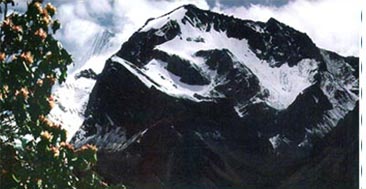1. |
| |
|
AFGHANISTAN FACTOR IN CENTRAL AND SOUTH ASIAN POLITICS
Edited by Prof. K. Warikoo
New Delhi, Trans-Asia Informatics, 1994. 73 pp.
Content
| 1. |
Cockpit of Central Asia: Afghanistan factor in Tajikistan's Crisis |
1-22 |
| |
K. Warikoo |
|
| 2. |
Afghanistan Crisis: Regional Implications and Impact on Pakistan's Policy |
23-37 |
| |
Uma Singh |
|
| 3. |
Afghan Mujahideen and Terrorism in Kashmir |
38-48 |
| |
A.K. Ray |
|
| |
Appendices |
49-73 |
| |
|
|
|
 |
|
2. |
| |
|
SOCIETY AND CULTURE IN THE HIMALAYAS
Edited by Prof. K. Warikoo
New Delhi, Har-Anand Publications, 1995. 316 pp.
Content
| Part I: Ecological Rerspective |
|
| 1. |
Ecological Evaluation of Land use system for Development Planning in the Himalayas, |
17-43 |
| |
P.S. Ramakrishanan, K.G. Saxena and K.S. Rao |
|
| |
|
|
| 2. |
Himalayas: An Eco-cultural Prespective, |
44-50 |
| |
P. Kachroo |
|
| |
|
|
| 3. |
Changing Relationship between Human Society and Aquatic Eco-systems in the Kashmir Himalayas, |
51-65 |
| |
A.R. Yousuf |
|
| |
|
|
| Part II: Geopolitical Imperative |
|
| 4. |
Himalayas- The Geopolitical Imperatives, |
69-103 |
| |
T.N. Dhar |
|
| |
|
|
| 5. |
The Himalayan Frontier: Some Strategic Aspects, |
104-111 |
| |
A.K. Ray |
|
| |
|
|
| 6. |
The Shahidulla Affair: British Policy towards Kashmir's claims across the Karakoram, |
112-124 |
| |
K. Warikoo |
|
| |
|
|
| Part III: Society and Culture |
|
| 7. |
Kashmir: A Crucible of Cultural Interaction, |
127-139 |
| |
P.N. Pushp |
|
| |
|
|
| 8. |
Dynamics of Change in Class Relations in Kashmir: An Agrarian-Hisrorical Prespective, |
140-162 |
| |
D.N. Dhar |
|
| |
|
|
| 9. |
The Last three centuries of Bhotias of the Himalayas, |
163-178 |
| |
S.K. Pathak |
|
| |
|
|
| 10. |
Gujjars of Himalayas: Some Reflections, |
179-186 |
| |
Shamsheer Hakla Poonchi |
|
| |
|
|
| 11. |
The Adis: A study of their origin and Migration, |
187-198 |
| |
Tamo Mibang |
|
| |
|
|
| 12. |
The Socio-cultural Pattern of Sikkim: Prespectives and Prospects, |
199-216 |
| |
Aparna Battacharya |
|
| |
|
|
| Part IV: Modernisation and Change |
|
| 13. |
Kashmiri society: Dynamics of Social change, |
219-231 |
| |
K.N. Pandita |
|
| |
|
|
| 14. |
Impact of Modernisation on Society and Culture of Sikkim, |
232-247 |
| |
Prem Singh Jina |
|
| |
|
|
| 15. |
Delemma of Gujjars in Jammu and Kashmir, |
248-274 |
| |
R.P. Khatana |
|
| |
|
|
| 16. |
Impact of Modernisation on Society and Culture of Sikkim, |
275-286 |
| |
Yeshi Choedon |
|
| |
|
|
| 17. |
mpact of Education on Socio-economic and Cultural life of Arunachal Pradesh, |
287-298 |
| |
S. Dutta |
|
| |
|
|
| 18. |
Prospects of Sustainable Development in an Encapsulated Eco-system: A Case study of Pangi Valley (Himachal Pradesh), |
299-310 |
| |
D.K. Shahi |
|
| |
|
|
| |
Select Bibliography |
311-312 |
| |
|
|
| |
Index |
313-317 |
| |
|
|
|
 |
|
3. |
| |
 |
CENTRAL ASIA : EMERGING NEW ORDER
Edited by Prof. K. Warikoo
New Delhi, Har-Anand Publications, 1995. 352 pp.
Content
| SECTION I : Problems of Transition |
|
| 1. |
Emerging Scenario,
K.Warikoo |
17-34 |
| |
|
|
| 2. |
Paradoxes of Transition,
R.R. Sharma |
35-46 |
| |
|
|
| 3. |
The New Political Institutions of Independent Kazakhstan,
Z. Dzhunusovaand D. Balgamis |
47-57 |
| |
|
|
| 4. |
The Republics of Central Asia and the Problems of
the Middle-East Integration,
G. Khidayatov |
58-60 |
| |
|
|
| SECTION II : Ethnicity, Religion and Nationalism |
| 5. |
Sufi Movements: Search for Identity and Islamic Resurgence,
T. Zarcone |
63-79 |
| |
|
|
| 6. |
Language and Cultrue in the Politics of Tajikistan,
K.N. Pandita |
80-95 |
| |
|
|
| 7. |
Ethno-Nationalism in Uzbekistan,
P.L. Dash |
96-116 |
| |
|
|
| 8. |
Uighurs in the Independent State of Kazakhstan,
G.I. Semyatova |
117-123 |
| |
|
|
| SECTION III : Economic Potential and Prospects |
| 9. |
Economic Stabilization and Structural Changes: Some
Implications,
Jayashekar |
127-133 |
| |
|
|
| 10. |
Economic Transition: Issues and Problems,
R.G. Gidadhubli |
134-144 |
| |
|
|
| 11. |
Transition to a Market Economy,
Ajay Patnaik |
145-165 |
| |
|
|
| SECTION IV : Regional Setting |
| 12. |
Problems of Regional Security and Nuclear Proliferation,
D. Banerjee |
169-192 |
| |
|
|
| 13. |
Cockpit of Central Asia: Afghanistan Factor in Tajikistan's
Crisis,
K. Warikoo |
193-225 |
| |
|
|
| 14. |
The Post-Soviet Central Asia and Russia: Emerging
Contours of a Relationship,
Devendra Kaushik |
226-246 |
| |
|
|
| 15. |
Relations Between Iran and Central Asia: An Overview,
Shirin
Akiner |
247-273 |
| |
|
|
| 16. |
Turkey and Former Soviet Central Asia: A Turkic Culture
Area in the Making,
Gareth M. Winrow |
274-298 |
| |
|
|
| 17. |
Pakistan and the Central Asian Republics,
Surendra Chopra |
299-327 |
| |
|
|
| 18. |
Central Asian Republics and Middle-East Security,
A.K. Ray |
328-338 |
| |
|
|
| 19. |
Mongolia and Central Asia: Emerging Relations,
K. Warikoo and S.K. Soni |
339-345 |
| |
|
|
| |
Select Bibliography |
346-348 |
| |
|
|
| |
Index |
349-352 |
| |
|
|
|
 |
|
4. |
| |
 |
JAMMU, KASHMIR AND LADAKH : LINGUISTIC PREDICAMENT
Edited by Prof. P.N. Pushp and Prof. K. Warikoo
New Delhi, Har-Anand Publications, 1996. 224 pp.
Content
| 1. |
Kashmiri and the Linguistic Predicament of the State,
P.N. Pushp |
13-29 |
| |
|
|
| 2. |
Kashmiri Language: Roots, Evolution and Affinity,
S.S. Toshkhani |
30-79 |
| |
|
|
| 3. |
The Sharada Script: Origin and Development,
B.K. Kaul Deambi |
80-100 |
| |
|
|
| 4. |
The dogri Language,
Ved Kumari Ghai |
101-108 |
| |
|
|
| 5. |
Gujari Language and Identity in Jammu and Kashmir,
R.P.
Khatana |
109-128 |
| |
|
|
| 6. |
Sanskritic Impact on the Speech of Ladakhi Garkhuns,
Malvika
Bandyopadhyaya |
129-134 |
| |
|
|
| 7. |
The Balti Language,
Syed Mohammad Abbas Kazmi |
135-153 |
| |
|
|
| 8. |
Generic Affinity of Balti, Bodhi, Spiti & Lahuli
Speeches,
S.K. Pathak |
154-164 |
| |
|
|
| 9. |
Urdu in Jammu and Kashmir,
Nishat Ansari |
165-173 |
| |
|
|
| 10. |
Hindi in Kashmir,
R.K. Sharma |
174-182 |
| |
|
|
| 11. |
Language and Politics in Jammu and Kashmir: Issues
and Perspectives,
K. Warikoo |
183-212 |
| |
|
|
| |
Appendices |
213-221 |
| |
|
|
| |
Select Bibliography |
222-224 |
| |
|
|
|
 |
|
5. |
| |
 |
ARTISAN OF THE PARADISE: A STUDY OF ART AND ARTISANS OF KASHMIR
By D.N. Dhar
New Delhi, Bhavana Books & Prints, 1999. 230pp.
Content
| 1. |
Place of Kashmir Artisan in the Ancient Civilizations
of the World |
1-22 |
| |
|
|
| 2. |
From the Oasis to a Mirage |
23-38 |
| |
|
|
| 3. |
The Rise and Collapse in 19th Century |
39-63 |
| |
|
|
| 4. |
Odyssy of the Shawl |
64-82 |
| |
|
|
| 5. |
Artisan of the Paradise |
83-90 |
| |
|
|
| 6. |
The Revolt |
91-96 |
| |
|
|
| 7. |
Artisans from the Vanguard |
97-107 |
| |
|
|
| 8. |
Socialist Ideas Permeate the Valley |
108-118 |
| |
|
|
| 9. |
On the Path of Progress |
119-133 |
| |
|
|
| 10. |
Handloom Weaving - Silk, Woollens and Pashmina |
134-144 |
| |
|
|
| 11. |
Carpets, Namdas and Gabbas |
145-159 |
| |
|
|
| 12. |
Embroidery, Crewel and Sozni |
160-168 |
| |
|
|
| 13. |
Papier-Mache, Wood Carving and other Crafts |
169-180 |
| |
|
|
| 14. |
Conclusion |
181-190 |
| |
|
|
| |
Appendices |
191-212 |
| |
|
|
| |
Bibliography |
213-218 |
| |
|
|
| |
Index |
219-230 |
| |
|
|
|
 |
|
| |
 |
6. |
| |
 |
Afghanistan: The Challenge
Edited by K. Warikoo (New Delhi, 2007, 377pp.)
Content
| |
Preface |
vii |
| |
|
|
| |
Contributors |
xxv |
| |
|
|
| 1. |
Rebuilding the Afghan State: the International Dimension |
1 |
| |
|
|
| 2. |
Challenges to Democratization, Peace and Stability in Afghanistan |
26 |
| |
|
|
| 3. |
Problems and Prospects of Constitutional Government in Afghanistan |
49 |
| |
|
|
| 4. |
Afghan Drugs and European Markets |
81 |
| |
|
|
| 5. |
Afghanistan and Central Asia: Differentiated Challenges and Priorities in the Twenty First Century |
96 |
| |
|
|
| 6. |
US Policy Towards post-September 11 Afghanistan |
110 |
| |
|
|
| 7. |
Pakistan’s Afghanistan Policy: Post 9/11 |
128 |
| |
|
|
| 8. |
In Pursuit of Strategic Depth: The Changing Dynamics of Pakistan's Afghan Policy |
137 |
| |
|
|
| 9. |
India and Afghanistan: Renewing Economic Relations |
163 |
| |
|
|
| 10. |
Afghanistan Factor in Kashmir Crisis |
195 |
| |
|
|
| 11. |
The Taliban Resurrection and the Changing Course of Afghan Civil War |
227 |
| |
|
|
| 12. |
Appendices |
|
| |
|
|
| |
I. |
UN Security Council Resolution 1444 (2002) adopted at its 4651st meeting
on 27 November 2002 |
252 |
| |
|
|
|
| |
II. |
Kabul Declaration on Good Neighbourly Relations, 22 December 2002 |
254 |
| |
|
|
|
| |
III. |
Report of the UN Security Council Mission to Afghanistan,
31 October to 7 November 2003 |
256 |
| |
|
|
|
| |
IV. |
UN Security Council Resolution 1536 (2004) adopted at its 4937th meeting on 26 March 2004 |
270 |
| |
|
|
|
| |
V. |
UN Security Council Resolution 1589 (2005) adopted at its 5148th meeting
on 24 March 2005 |
274 |
| |
|
|
|
| |
VI. |
UN Security Council Resolution 1623 (2005) adopted at its 5260th meeting
on 13 September 2005 |
278 |
| |
|
|
|
| |
VII. |
Report of the UN Special Rapporteur on Violence Against Women, its Causes and Consequences, on Her Mission to Afghanistan |
281 |
| |
|
|
|
| |
VIII. |
UN Security Council Resolution 1659 (2006) adopted at its 5374th meeting
on 15 February 2006 |
311 |
| |
|
|
|
| |
IX. |
Report of the UN High Commissioner for Human Rights on the Situation of Human Rights in Afghanistan and on the Achievements of Technical Assistance in the field of Human Rights dated 3 March 2006 |
314 |
| |
|
|
|
| |
X. |
Report of the UN Secretary General on the Situation in Afghanistan and its Implications for International Peace and Security dated 7 March 2006 |
339 |
| |
|
|
|
| |
XI. |
UN Security Council Resolution 1662 (2006) adopted at its 5393rd meeting
on 23 March 2006 |
365 |
| |
|
|
|
| |
|
Index |
370 |
| |
|
|
|
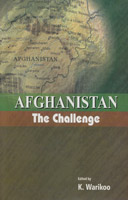 |
|
| |
|
7. |
| |
 |
Drugs Production and Trafficking In Afghanistan
By Deepali Gaur Singh (New Delhi, 2007, xxiii, 380pp.).
Content
| Foreword |
v |
| |
|
| Preface |
ix |
| |
|
| Acknowledgements |
xvii |
| |
|
| List of Maps, Graphs, Tables and Figures |
xxiii |
| |
|
| |
|
| 1. INTRODUCTION |
|
| |
HISTORY |
1 |
| |
|
|
| |
The First Afghan Empire |
13 |
| |
|
|
| |
The Great Game |
17 |
| |
|
|
| |
The First Anglo-Afghan War |
18 |
| |
|
|
| |
The Second Anglo-Afghan War |
19 |
| |
|
|
| |
AFGHANISTAN DURING THE COLD WAR PERIOD |
23 |
| |
|
|
| |
Afghanistan’s Growing ‘Trade’ and Relations with both Superpowers |
26 |
| |
|
|
| |
The Soviet Intervention and its Aftermath |
27 |
| |
|
|
| |
The Soviets Invade |
28 |
| |
|
|
| |
The Franco-American Venture and ‘Operation Mosquito’ |
30 |
| |
|
|
| |
THE ETHNIC FRAMEWORK |
34 |
| |
|
|
| |
Pashtuns |
35 |
| |
|
|
| |
Tajiks |
36 |
| |
|
|
| |
Hazaras |
37 |
| |
|
|
| |
Uzbeks |
38 |
| |
|
|
| |
Baluch |
38 |
| |
|
|
| |
Aimaq |
39 |
| |
|
|
| |
Turkmen |
39 |
| |
|
|
| |
Nuristani |
40 |
| |
|
|
| |
A PASTORAL ECONOMY |
40 |
| |
|
|
| |
A WAR-BASED ECONOMY |
40 |
| |
|
|
| 2. |
THE MUJAHIDEEN AND DRUG LORDS |
54 |
| |
|
|
| |
THE MUJAHIDEEN |
57 |
| |
|
|
| |
Hizb-i-Islami |
58 |
| |
|
|
| |
Hizb-i-Islami (Islamic Party/Khalis) |
59 |
| |
|
|
| |
Jamiat-i-Islami |
60 |
| |
|
|
| |
Ittihad-i-Islami |
61 |
| |
|
|
| |
Harkat-e-Inquilabi-e-Islami (Islamic Revolutionary Movement) |
62 |
| |
|
|
| |
The Mahaz-e-Milli Islami Afghanistan (National Islamic Front of Afghanistan) |
63 |
| |
|
|
| |
The Jabba-e-Nejat-e-Milli Afghanistan (Afghan National Liberation Front) |
63 |
| |
|
|
| |
DRUG TRADE FINANCES THE JIHAD |
69 |
| |
|
|
| |
FREEDOM FIGHTERS OR DRUG PEDDLERS |
77 |
| |
|
|
| |
THE DRUG LORDS AND THEIR MASTERS |
81 |
| |
|
|
| 3. |
THE TALIBAN– PATRONS OF THE DRUG TRADE |
97 |
| |
|
|
| |
THE TALIBAN |
99 |
| |
|
|
| |
The Initial Advance of the Taliban |
107 |
| |
|
|
| |
DRUGS - THE MAINSTAY OF THE TALIBAN ECONOMY |
119 |
| |
|
|
| |
A WELL-OILED NARCOTICS NETWORK |
133 |
| |
|
|
| |
The Transport Mafia |
135 |
| |
|
|
| |
THE POST-SEPTEMBER 11, 2001 SCENARIO |
140 |
| |
|
|
| 4. |
AFGHANISTAN – CENTRE OF NARCOTICS PRODUCTION AND DRUG TRAFFICKING |
151 |
| |
|
|
| |
A BACKGROUND TO REGIONAL POLITICS |
158 |
| |
|
|
| |
The Initial Joint Exercises |
161 |
| |
|
|
| |
The ISI Connection |
165 |
| |
|
|
| |
Growth in the Arms Trade |
170 |
| |
|
|
| |
The Drug Trade |
173 |
| |
|
|
| |
THE GROWTH IN OPIUM PRODUCTION IN AFGHANISTAN |
175 |
| |
|
|
| |
TRAFFICKING, REGIONAL CONSUMPTION AND ABUSE |
198 |
| |
|
|
| 5. |
DRUG MONEY AND THE ARMS TRADE |
215 |
| |
|
|
| |
ARMS FOR DRUGS |
220 |
| |
|
|
| |
The Main Trafficking Routes |
227 |
| |
|
|
| |
The Other Costs |
231 |
| |
|
|
| |
The Drugs Pipeline |
236 |
| |
|
|
| |
Bankers for the Jihad or ‘Bank of Crooks and Criminals International?’ |
243 |
| |
|
|
| |
Drugs and International Terrorism |
249 |
| |
|
|
| 6. |
IMPLICATIONS FOR REGIONAL SECURITY |
267 |
| |
|
|
| |
The Iranian Concern |
268 |
| |
|
|
| |
What it Cost Pakistan |
274 |
| |
|
|
| |
Implications for the Central Asian Republics and the Russian Federation |
283 |
| |
|
|
| |
A United Front to Combat the Drug Menace |
291 |
| |
|
|
| |
Trade in Precursors |
295 |
| |
|
|
| |
The Indian Position |
301 |
| |
|
|
| |
1953 Opium Protocol |
308 |
| |
|
|
| 7. |
CONCLUSION |
315 |
| |
|
|
| |
Maps |
336 |
| |
|
|
| |
Bibliography |
360 |
| |
|
|
| |
Index |
378 |
| |
|
|
|
 |
|
| |
|
8. |
| |
 |
Cultural Heritage of Kashmiri Pandits
Edited by S. S. Toshkhani and K. Warikoo (Pentagon Press, New Delhi, 2009, xxviii, 364pp.)
Content
| List of Illustrations |
Vii |
| |
|
| Preface |
ix |
| |
|
| |
|
| |
|
|
|
|
|
|
|
| 1 |
Kashmiri Pandits and India’s Cultural Traditions |
S. S. Toshkhani |
1 |
| |
|
|
| 2 |
Kashmiri Pandits through History: From the Early Times to 1947 |
Tej N Dhar |
22 |
| |
|
|
| 3 |
Abhinavagupta and the Shaivite Tradition of the Sarada Desa |
Rajnish Mishra |
34 |
| |
|
|
| 4 |
Social Structure and Cultural Identity of Kashmiri Pandits |
S. S. Toshkhani |
62 |
| |
|
|
| 5 |
Religious Rituals and Ritual Arts of Kashmiri Hindus |
S.S. Toshkhani |
84 |
| |
|
|
| 6 |
Kashmir’s Contribution to Sanskrit Poetry and Poetics |
Ved Kumari Ghai |
91 |
| |
|
|
| 7 |
Some Kashmiri Pandit Historiographers |
Mushtaq A. Kaw |
101 |
| |
|
|
| 8 |
Shrines and Pilgrimage Places |
K. Warikoo |
107 |
| |
|
|
| 9 |
Amarnath – The Abode of the God of Immortality |
K. Warikoo |
130 |
| |
|
|
| 10 |
In Search of Roots |
A. R. Nazki |
139 |
| |
|
|
| 11 |
Shankaracharya and Some Kashmiri Pandit Traditions |
Rashnik Kher |
148 |
| |
|
|
| 12 |
Beginnings of Bhakti in Kashmir |
S. S. Toshkhani |
157 |
| |
|
|
| 13 |
Lal Ded and Her Spiritual Journey |
S. S. Toshkhani |
166 |
| |
|
|
| 14 |
Political Content in the Vaakhs of Lal Ded |
R L Bhat |
190 |
| |
|
|
| 15 |
The Mystic and the Romantic: Two Kashmiri Women Poets - Rupa Bhavani and Arnimal |
Neerja Mattoo |
205 |
| |
|
|
| 16 |
Paramanand: Devotional Raptures of Krishna Lila |
S.S. Toshkhani |
218 |
| |
|
|
| 17 |
Prakash Ramayana and other Works on Ramayana Theme in Kashmiri |
S.S. Toshkhani |
233 |
| |
|
|
| 18 |
Krishnajoo Razdan – Melodic Expression of Devotional Ecstasy |
S.S. Toshkhani |
253 |
| |
|
|
| 19 |
Swami Lakshman Joo: The Sage of Ishaber |
Jankinath Kaul ‘Kamal’ |
272 |
| |
|
|
| 20 |
Kashmiri Pandits – Originators of Pahari-Kangra School of Art |
P.N. Kachru |
281 |
| |
|
|
| 21 |
Kashmir’s Contribution to the Visual Imagery at Alchi |
Geetika Kaw Kher |
292 |
| |
|
|
| 22. |
Deodar in a Storm: Nadim and the Pantheon |
Braj B. Kachru |
306 |
| |
|
|
| 23 |
Kashmiri Pandits in Journalism |
M. L. Kak |
326 |
| |
|
|
| 24 |
Kashmiri Pandits in Retrospect and Prospect |
K. Warikoo |
336 |
| |
|
|
| |
Index |
|
360 |
| |
|
|
| |
Contributors |
|
364 |
| |
|
|
|
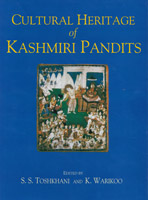 |
|
| |
|
9. |
| |
 |
Cultural Heritage of Jammu and Kashmir
Edited by K. Warikoo (Pentagon Press, New Delhi, 2009, xii, 338pp.)
Content
| Preface |
v |
| |
|
| Contributors |
ix |
| |
|
| List of Plates/Photographs |
xi |
| |
|
|
|
|
|
|
|
| 1 |
Rock Art of ‘Northern Areas’ |
Muhammad Arif |
1 |
| |
|
|
| 2 |
Kashmir’s Contribution to Indian Aesthetics |
S .S. Toshkhani |
16 |
| |
|
|
| 3 |
Buddhist Heritage of Kashmir |
Advaitavadini Kaul |
33 |
| |
|
|
| 4 |
Promoting and Preserving Buddhist Tradition in Ladakh |
Nawang Tsering |
44 |
| |
|
|
| 5 |
Genesis and Development of Kashmir Bronzes |
Sunil Khosa |
54 |
| |
|
|
| 6 |
Kashmir Shaivism |
B. N. Pandit |
64 |
| |
|
|
| 7 |
Kashmir: The Land of Sanskrit Poetry and Poetics |
Ved Kumari Ghai |
71 |
| |
|
|
| 8 |
Ancient Temples of Kashmir: An Architectural Study |
Virendra Bangroo |
83 |
| |
|
|
| 9 |
Temple Architecture of Jammu Shivaliks |
Lalit Gupta |
94 |
| |
|
|
| 10 |
Influence of Advaita on Muslim Rishis of Kashmir |
T.N.Dhar ‘Kundan’ |
101 |
| |
|
|
| 11 |
Sufism and Rishiism in Kashmir |
Hamidullah Marazi |
113 |
| |
|
|
| 12 |
Mystic Poetry: Lal Ded, a Major Voice |
Neerja Mattoo |
127 |
| |
|
|
| 13 |
Nund Rishi: A Brief Introduction |
A. N. Dhar |
139 |
| |
|
|
| 14 |
Shrines and Pilgrimage Places of Kashmir |
K. Warikoo |
149 |
| |
|
|
| 15 |
Hazratbal: A Crescent of Faith |
Pirzada M. Amin |
167 |
| |
|
|
| 16 |
Sacred Springs of Jammu Shivaliks |
Lalit Gupta |
187 |
| |
|
|
| 17 |
Cultural Vistas in Kashmiri Folklore |
P.N. Pushp |
200 |
| |
|
|
| 18 |
Shia Muslims of Kashmir: An Ethno-Cultural Study |
Ali Mohmmad Rather |
212 |
| |
|
|
| 19 |
The Balti: A Marginal Tribe of Jammu and Kashmir |
B.R. Rizvi |
237 |
| |
|
|
| 20 |
Folk Heritage of Gujjars of Jammu and Kashmir |
Javaid Rahi |
248 |
| |
|
|
| 21 |
The Dying Linguistic Heritage of Kashmiri Literary Culture and Language |
Braj B. Kachru |
258 |
| |
|
|
| 22. |
Role of Dogri Sanstha in Promotion of Dogri Language, Literature and Culture |
Lalit Magotra |
286 |
| |
|
|
| 23 |
Modern Art Movement in Kashmir |
P.N. Kachru |
293 |
| |
|
|
| 24 |
Unrest in Kashmir: Perceptions and Reflections in Kashmiri Literature (1980-2000) |
R.L. Shant |
310 |
| |
|
|
| 25 |
Kashmiriyat: The Mystique of an Ethnicity |
Riyaz Punjabi |
320 |
| |
|
|
| |
Index |
|
334 |
| |
|
|
|
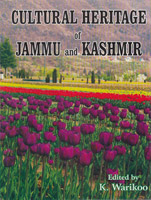 |
|
| |
|
10. |
| |
 |
Central Asia and South Asia: Energy Cooperation and Transport Linkages
Edited by K. Warikoo (Pentagon Press, New Delhi, 2011, 293pp.)
Content
| |
|
| |
|
|
vi |
| |
|
|
ix |
| |
|
PART I
ENERGY COOPERATION |
| 1 |
New Geopolitics of Hydrocarbon Resources: A Eurasian Perspective |
Devendra Kaushik |
3 |
| |
|
|
| 2 |
Asian Energy Projects in Caspian Basin |
Shirin Akiner |
20 |
| |
|
|
| 3 |
Energy Resources of Central Asia and Geopolitics of Pipelines |
R.G. Gidadhubli |
36 |
| |
|
|
| 4 |
Yin and Yang of the Caspian Conundrum |
P.L. Dash |
46 |
| |
|
|
| 5 |
Russia’s Energy Policy in Central Asia: Imperatives for India |
Irina Morozova |
59 |
| |
|
|
| 6 |
Kazakhstan's Energy Strategy |
Bek Ali Yerzhan |
68 |
| |
|
|
| 7 |
Kazakhstan’s Energy Policy and Cooperation with India |
Oxana Dolzhikova |
77 |
| |
|
|
| 8 |
Indo-Kazakh Cooperation in Kazakhstan’s Oil and Gas Sector |
Yelena I. Rudenko |
86 |
| |
|
|
| 9 |
China’s Energy Cooperation with Central Asia |
Xu Qinhua |
96 |
| |
|
|
| 10 |
India-China Competition and Cooperation in Energy Resources |
Nawal K. Paswan |
105 |
| |
|
|
| 11 |
The Iran-Pakistan-India Pipeline |
Savita Pande |
164 |
| |
|
|
| 12 |
Turkmenistan-Afghanistan-Pakistan-India (TAPI): Pipeline or Pipedream? |
Mahesh Ranjan Debata |
178 |
| |
|
|
PART II
TRANSPORT LINKAGES |
| 13 |
Pipelines as a “Means of Transport” for the Land-Locked Caspian Basin |
Martin Ira Glassner
and Avinoam Idan |
195 |
| |
|
|
|
| 14 |
The Great Silk Route: Historical Perspective |
Victor M. Mitypov |
203 |
| |
|
|
|
| 15 |
The Trans-Siberian Railway: Eurasian Resource |
M. Baldano |
203 |
| |
|
|
|
| 16 |
North-South Corridor: Prospects and Challenges for India |
Meena Singh Roy |
222 |
| |
|
|
|
| 17 |
Ladakh: India’s Gateway to Central Asia |
K. Warikoo |
240 |
| |
|
|
|
| 18 |
Transport Corridor between Central Asia-India through Pakistan: Possible Routes and SRMTS |
Neeladri Chatterjee |
248 |
| |
|
|
|
| 19 |
Gwadar Port: A South Asian Gateway for Central Asia? |
Alok Bansal |
256 |
| |
|
|
|
| 20 |
India and Afghanistan: Options for Access and Trade |
Mondira Dutta |
268 |
| |
|
|
|
| |
Index |
|
288 |
| |
|
|
|
| |
|
|
|
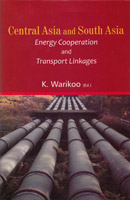 |
|
| |
|
11. |
| |
 |
Cultural Heritage of Kashmiri Pandits
By S. S. Toshkhani (Pentagon Press, New Delhi, 2010, 237pp.)
Content
| 1 |
Introduction |
1 |
| |
|
|
| 2 |
Primary Texts and Sources of Inquiry |
23 |
| |
|
|
| 3 |
Life-cycle Rituals – Childhood Samskaras |
46 |
| |
|
|
| 4 |
Mekhal or Sacred Thread Investiture |
58 |
| |
|
|
| 5 |
Marriage Ceremonies |
76 |
| |
|
|
| 6 |
Funerary and Post-funerary Rites |
97 |
| |
|
|
| 7 |
Daily Rites and other Rituals |
121 |
| |
|
|
| 8 |
Puja Rites and Festivals |
152 |
| |
|
|
| 9 |
Ritual Arts |
195 |
| |
|
|
| 10 |
Conclusions |
215 |
| |
|
|
| |
Bibliography |
224 |
| |
|
|
| |
Index |
233 |
| |
|
|
|
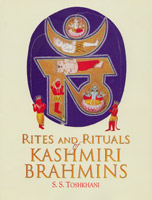 |
|
| |
|
12. |
| |
 |
Mongolia in the 21st Century: Society, Culture and International Relations
Edited by K. Warikoo and Sharad K. Soni (Pentagon Press, New Delhi, 2010, xvii, 374pp.)
Content
|
|
|
|
|
|
|
| 1 |
Statehood Traditions of Mongolian Nomads |
B. Enkhtuvshin |
1 |
| |
|
|
| 2 |
Mongolian Influence on the Ottoman Institutional Structure |
A. Melek Özyetgin |
11 |
| |
|
|
| 3 |
Documents Related to Mongolia in Turkish Archives and Japan-Mongolian Relations |
A. Merthan Dundar |
22 |
| |
|
|
| 4 |
Mongolic Elements in the Hazaragi Language of Afghanistan and their Value for Reconstructing Western Middle Mongol |
Andrew Shimunek |
29 |
| |
|
|
| 5 |
Nationalism and Mongols |
Olzvoi Battumur |
46 |
| |
|
|
| 6 |
Mongolian Language and Culture in National Identity |
B. Uranchimeg |
51 |
| |
|
|
| 7 |
Chinggis Khan in Literary Memory: Identity Formation in Mongolia |
Sindhu Rao |
57 |
| |
|
|
| 8 |
Mongolia’s National Security: Past, Present and Future Perspectives |
A. Tuvshintugs |
71 |
| |
|
|
| 9 |
Economic Security of Mongolia: Some Perspectives |
J. Gulgou |
84 |
| |
|
|
| 10 |
Women and Development in Contemporary Mongolia |
Maqsooda Shitoni |
89 |
| |
|
|
| 11 |
India and Mongolia |
Gauri Shankar Gupta |
106 |
| |
|
|
| 12 |
The Mongols and Prof. Raghuvira |
Lokesh Chandra |
123 |
| |
|
|
| 13 |
Links between Indian and Mongolian Literature: Some Perspectives |
Yü. Mönkh-Amgalan and G. Galbayar |
132 |
| |
|
|
| 14 |
Landlocked Mongolia and its Trade and Economic Cooperation with India |
O. Nyamdawaa |
139 |
| |
|
|
| 15 |
Trade and Investment Cooperation between India and Mongolia |
Nawal K. Paswan |
154 |
| |
|
|
| 16 |
Stabilising Borders: Sino-Mongolian Relations |
Srikanth Kondapalli |
207 |
| |
|
|
| 17 |
Contemporary Mongolia-Russia Relations |
Luvsan Khaisandai |
228 |
| |
|
|
| 18 |
Russia-Mongolia Relations in the 21st Century |
Elena Boykova |
233 |
| |
|
|
| 19 |
Mongolia-Russia Relations: Some Perspectives |
İlyas Kamalov |
237 |
| |
|
|
| 20 |
U.S. Policy towards Mongolia since Diplomatic Recognition in 1987 |
Alicia Campi |
246 |
| |
|
|
| 21 |
Bridging the Gap in Sino-Mongolian Ties: Role of Inner Mongolia |
Sharad K. Soni |
256 |
| |
|
|
| 22. |
Transformation of Traditional Culture in Inner Mongolia |
Baohua |
304 |
| |
|
|
| 23 |
Buryatia and the Idea of United Mongolian State |
M.N. Baldano |
313 |
| |
|
|
| 24 |
Tradition and Culture in Buryatia |
K. Warikoo |
323 |
| |
|
|
| 25 |
Buddhist Church in Socio-Cultural Space of Russia |
V.M. Mitypov |
336 |
| |
|
|
| 26 |
Tuva-Russia Relations in Historical Perspective |
Sharad K. Soni |
346 |
| |
|
|
| 27 |
Mongolia and Kalmykia: Past and Present |
Yelena B. Pokaninova |
]
359 |
| |
|
|
| 28 |
Problems of Oralmans from Mongolia: The Migration Policy in Kazakhstan |
L.K. Shotbakova |
364 |
| |
|
|
| |
Index |
|
371 |
| |
|
|
|
|
|
.jpg) |
|
| |
|
13. |
| |
 |
Adventures in Central Asia: A Hungarian in the Great Game
Edited by P.J. Marczell (Pentagon Press, New Delhi, 2007, xx, 223pp.)
Content
|
ix |
| |
|
| |
|
| |
|
| |
|
| |
|
| |
| List of Illustrations |
xvii |
|
| SECTION I |
|
|
|
| A Reckless Life: Berzenczey’s Short Biography |
3 |
| |
|
|
| Berzenczey’s Central Asian Venture |
11 |
| |
|
|
| |
The Political Background |
11 |
| |
|
|
| |
Berzenczey’s Novelty |
16 |
| |
|
|
| |
Berzenczey’s Purpose and the Model for his Search |
19 |
| |
|
|
| |
The Influence of Csoma de Koros |
22 |
| |
|
|
| |
Lead |
23 |
| |
|
|
| SECTION I |
| |
|
|
| The Articles in The Times of India, 1874 |
27 |
| |
|
| 1 |
Introductory Editorial, 12 August |
29 |
| |
|
| 2 |
From St. Petersburg, through Central Asia, to Bombay, 19 August |
35 |
| |
|
|
| 3 |
Idem, 20 August |
49 |
| |
|
|
|
| 4 |
Idem, 21 August |
|
63 |
| |
|
|
| 5 |
My Arrest in Kashgar, 21 August |
|
72 |
| |
|
|
| 6 |
In Kashgar, 24 August |
|
75 |
| |
|
|
| 7 |
In Yarkand with Mr. Forsyth, 25 August |
|
87 |
| |
|
|
| 8 |
From Yarkand to Ladakh, 25 August |
|
94 |
| |
|
|
| 9 |
From Yarkand to the Karakorum, 29 August |
|
96 |
| |
|
|
| 10 |
Over the Karakorum, 31 August |
|
104 |
| |
|
|
| 11 |
Idem, 3 September |
|
112 |
| |
|
|
| 12 |
In Ladakh, 4 September |
|
119 |
| |
|
|
| 13 |
Coming down the Himalayas, 5 September |
|
126 |
| |
|
|
| 14 |
Closing Editorial, 8 September |
|
132 |
| |
|
|
| 15 |
Communication, 30 September |
|
138 |
| |
|
|
| Appendices |
| |
|
|
| A. |
Forsyth’s Official Files Concerning Berzenczey |
|
143 |
| |
|
|
| B. |
Forsyth on Berzenczey (extracted from his book) |
|
152 |
| |
|
|
| C. |
Criticism of Berzenczey Expressed by Forsyth in Public |
|
154 |
| |
|
|
| D. |
The Melodramatic Story of Yakub Beg as told by the Ujfalvy Couple |
|
160 |
| |
|
|
| |
Bibliography |
|
171 |
| |
|
|
| |
Index |
|
175 |
| |
|
|
| |
Maps and Illustrations |
|
183 |
| |
|
|
| |
|
|
| |
|
|
|
|
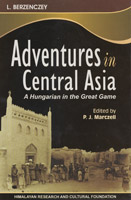 |
|
| |
|
|


